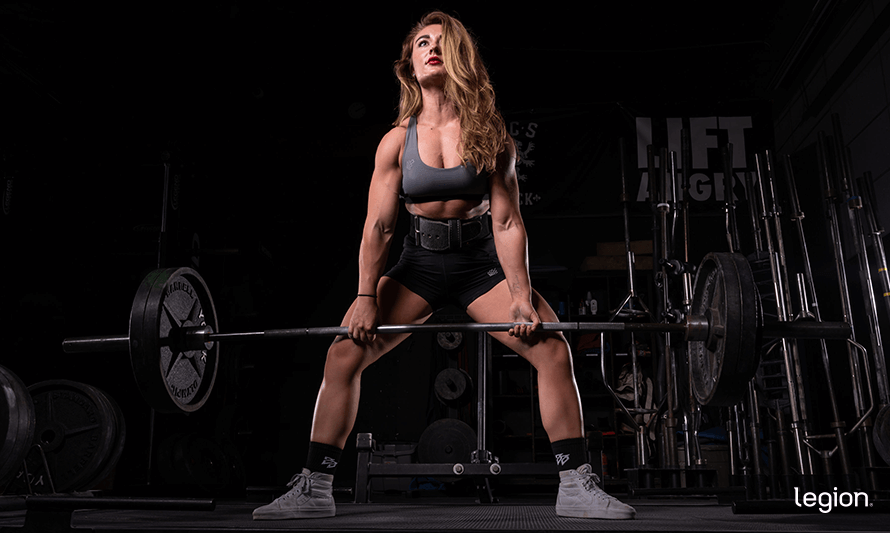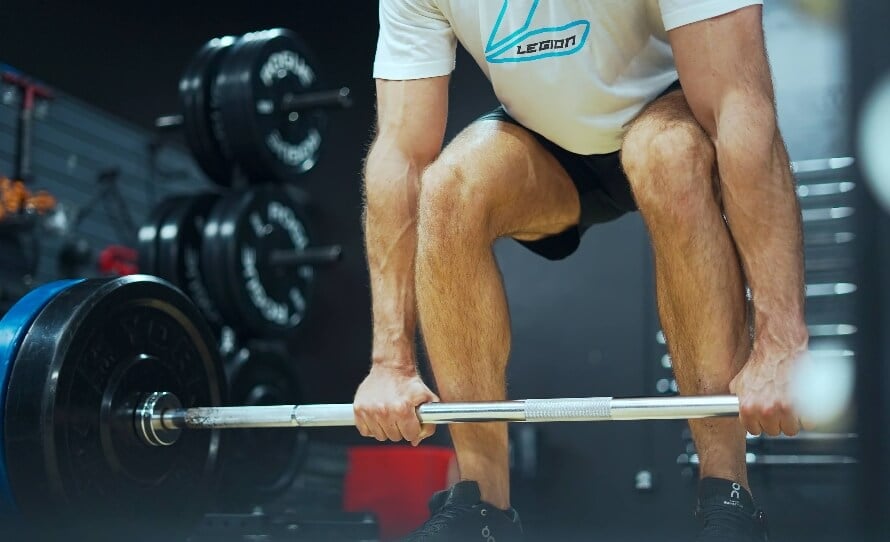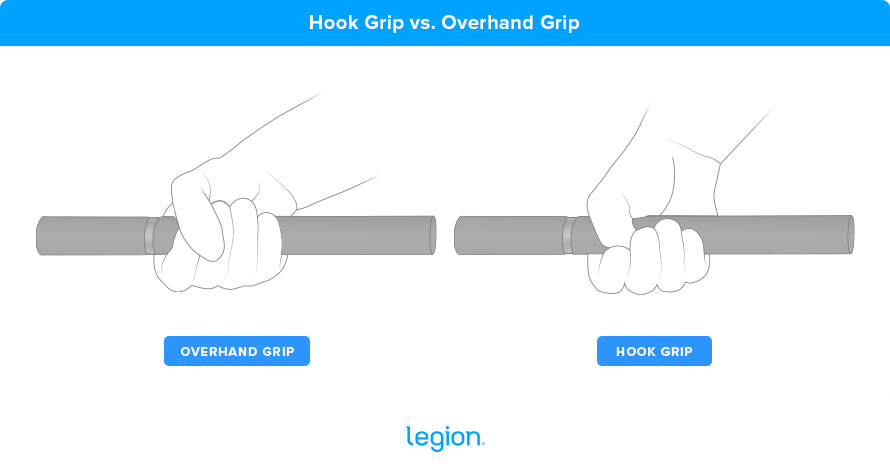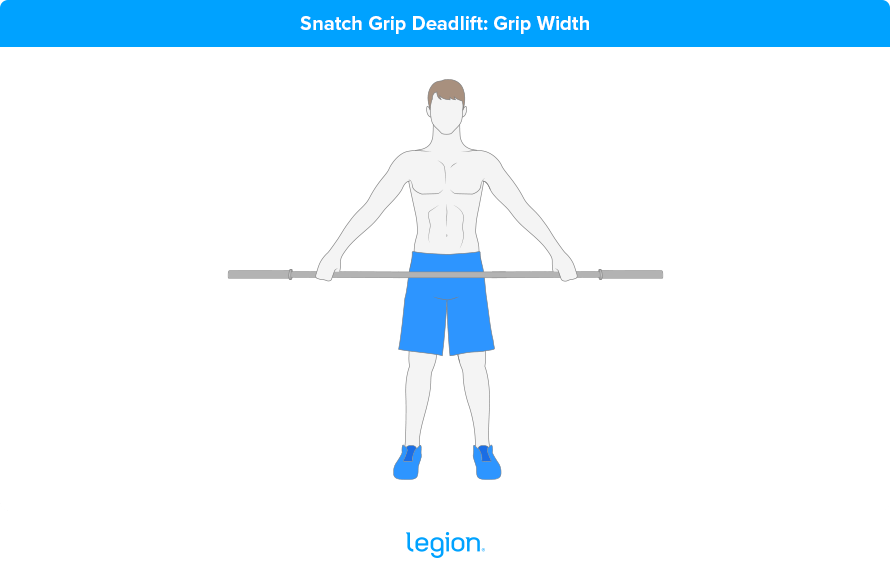You most likely know the deadlift is likely one of the finest workouts for gaining full-body power and measurement.
It builds all of the muscular tissues you should look robust—your traps, lats, forearms, abs, and thighs.
However right here’s the catch: your grip could make or break your deadlift efficiency.
In the event you’ve ever felt your again and legs have been prepared to drag heavier however the bar slipped out of your fingers, you already know the frustration of grip failure.
Getting your grip proper isn’t nearly transferring extra weight. It’s additionally about staying protected.
When your grip begins to fail, you’re extra more likely to compromise your type—rounding your decrease again, capturing your hips up, or shrugging the load. These shortcuts enhance your damage threat, particularly while you’re dealing with heavier masses.
That’s why on this article, we’re going to sort out every part you should find out about deadlift grips.
You’ll study concerning the 5 foremost grip types—double overhand with and with out straps, blended grip, hook grip, and snatch grip.
You’ll additionally uncover how to decide on the perfect grip on your objectives and strategies to strengthen your grip, decrease damage threat, and show you how to maintain the bar longer and extra securely.
Key Takeaways
- Your grip could make or break your deadlift efficiency—mastering the correct deadlift grips helps you raise heavier and keep protected.
- A stable deadlift grip begins with gripping the bar along with your fingers (not palms), squeezing as exhausting as doable, and pulling with environment friendly type on each rep.
- The 5 deadlift grips you should know are the overhand grip, blended grip, hook grip, double overhand grip with straps, and snatch grip.
- Newcomers ought to begin with a double overhand grip and progress to blended, hook, or strapped grips as they raise heavier weights.
- To enhance your deadlift grip power, deadlift frequently, keep away from straps on different workouts, do grip-specific coaching, and use chalk when wanted.
Deadlift Grip 101


Earlier than we speak concerning the totally different deadlift grips, let’s speak fundamentals.
Particularly, there are three easy guidelines for deadlift gripping that may enhance your efficiency no matter what type of grip you’re utilizing:
1. Grip the bar along with your fingers, not your palms.
A standard deadlift grip mistake that individuals make is gripping it of their palms, nearer to their wrist. This would possibly really feel safe while you’re getting arrange, however when you begin to ascend, the bar will slide into your fingers, throwing off your stability, type, and tempo.
The proper method to arrange your deadlift grip, then, is to start out with the bar in your fingers. This manner, the bar stays locked in place all through the complete motion, permitting you to deal with the gross motor actions.
2. Squeeze the bar as exhausting as you may on each rep.
One of many best methods to extend your power on nearly any barbell train is to easily grip the bar like your life is determined by it.
There’s a purpose powerlifters take into consideration “bending the bar in half” when bench urgent and “digging finger grooves” into it when pulling. They need their knuckles white for each rep as a result of it helps forestall the bar from rolling out of their fingers and will increase pressure manufacturing.
READ MORE: Find out how to Use Distant Voluntary Contraction to Immediately Get Stronger
3. Pull each rep with good type.
Poor type can compromise your grip by putting you at a biomechanical drawback and unnecessarily rising the time that the bar should stay in your fingers.
Getting this proper begins with a correct deadlift setup—along with your shoulders over or barely in entrance of the bar and your lumbar backbone (decrease again) in a impartial place, permitting you to drag the bar up in a roughly straight line.
Right here’s what I’m speaking about:
Discover how the bar begins a pair inches in entrance of my shins, how my shoulders and hips align, and the way the bar doesn’t waver to or fro as I pull?
That’s the way you deadlift with most effectivity and thereby mitigate the quantity of labor that your grip has to do and the extent to which it could actually get in the way in which.
READ MORE: Find out how to Deadlift with Correct Approach
The 5 Deadlift Grips That You Must Know


Most individuals suppose that the deadlift grip is all about uncooked grip power.
In the event you can’t preserve the bar from rolling out of your fingers, they are saying, you then simply want stronger fingers and forearms.
Effectively, that’s actually a limiting issue, however grip method can even maintain you again, and particularly in case you’re an intermediate or superior weightlifter.
At first, you don’t have the whole-body power to present your grip greater than it could actually deal with, however when you’ve put in a yr or so of exhausting work, the sport modifications.
At that time, your grip method turns into simply as necessary for the needs of security and progress as sustaining a impartial backbone, coordinating your hips and shoulders, and sustaining a straight bar path.
So, with all that in thoughts, let’s take a look at the 4 sorts of deadlift grips that you should find out about, beginning with the one you’re most likely most aware of.
Double Overhand Grip
In the event you stroll as much as a barbell, attain down, and seize it in the way in which that feels most pure, chances are high you’ll wind up with a double overhand grip.
That is additionally referred to as a “pronated grip,” and it appears like this:
As you may see, the fingers and thumbs wrapped across the bar, and the palms going through the shins.
The double overhand grip deadlift is a superb place to begin for individuals new to deadlifting as a result of it’s comfy and distributes weight evenly throughout either side of your physique, permitting you to deal with studying the extra technical points of the motion.
There’s an issue with the double overhand grip deadlift, although: it limits the quantity of weight that you could pull.
At a sure level—about 1.5 occasions physique weight, for many—your fingers are going to start out giving out, inflicting the bar to roll out of your fingers. And when that occurs, pressure manufacturing involves a screeching halt and also you get caught.
That is when most individuals transfer on from the double overhand grip deadlift, both by including straps, or switching to the blended grip deadlift.
Find out how to Set Up the Double Overhand Grip Deadlift
- Place your toes barely narrower than shoulder-width, with toes identified.
- Place a barbell about an inch out of your shins over your midfoot.
- Take a deep stomach breath, and grip the bar simply outdoors your shins with palms going through you.
- Nestle the bar as near the underside of your fingers and prime of your palms as doable, and squeeze as exhausting as you may.
Blended Grip
The blended grip is the double overhand grip with one hand flipped over, the palm going through away from the shins. Right here’s the way it appears:
That is additionally referred to as the “over-under grip,” and most of the people naturally discover it most comfy with their non-dominant hand going through their shins and their dominant hand going through away.
The largest good thing about the blended grip is it means that you can securely maintain much more weight than the double overhand grip as a result of it prevents the bar from rolling out of your fingers.
For instance, I actually can’t pull greater than about 400 kilos for a rep or two with a double overhand grip, however can, within the subsequent set, go as excessive because the 430s for 4-to-5 reps with the blended grip deadlift.
This works as a result of when one hand begins to flag and the bar desires to roll, it digs into the palm of the alternative hand, permitting it to stay caught in place.
The blended grip deadlift additionally has downsides, although:
- It tends to make you rotate your torso towards your palm going through you, making a load imbalance between the left and proper sides of your physique.
- It locations extra pressure on the biceps of your palm-away hand.
I don’t know of any scientific information on how this impacts the security of the train, however I’ll say this: whereas biceps tears are uncommon, once they do occur, it’s typically the palm-away biceps throughout a mixed-grip deadlift.
Now, that isn’t to say that it’s best to by no means use a blended grip since you’re going to inevitably injure your biceps.
As an alternative, you may take a easy precaution to make the blended grip safer: alternate your grip in particular person exercises or between them.
For instance, I prefer to deadlift with my non-dominant (left) hand going through me and my dominant hand going through away for my first set or two, after which, for my subsequent set or two, flip it round, going through my dominant hand towards me and my non-dominant hand away.
Another choice is switching your grip exercise to exercise, putting your dominant palm going through you in a single session after which going through away within the subsequent, or vice versa.
Both method, it is a good method to forestall overuse on one aspect of your physique and, thus, vastly cut back the possibilities of creating muscle imbalances or biceps strains or tears.
Find out how to Set Up the Blended Grip Deadlift
- Place your toes barely narrower than shoulder-width, with toes identified.
- Place a barbell about an inch out of your shins over your midfoot.
- Take a deep stomach breath, and grip the bar simply outdoors your shins along with your non-dominant hand going through you and your dominant hand going through away.
- Nestle the bar as near the underside of your fingers and prime of your palms as doable, and squeeze as exhausting as you may.
Hook Grip
In the event you’ve ever seen somebody deadlift an incredible quantity of weight with what appears like a double overhand grip, you’ve witnessed the hook grip.
The explanation you may’t inform them aside is that they’re very comparable, however with one essential distinction:
With the double overhand grip, your thumbs are wrapped across the bar. With the hook grip, although, your thumbs are positioned sideways on the bar and your fingers are wrapped over them, like this:


This lets you lock the bar in place and forestall any rolling, and it has gained loads of recognition within the powerlifting house as a viable different to each blended grip and strapping.
It has a serious downside, although: It hurts. Quite a bit.
Your thumbs get completely crushed by the load, a lot in order that the primary time you pull a heavy load with a hook grip, you’ll most likely suppose you’ve inflicted everlasting nerve harm.
To that time, some individuals say it does simply that—“deadening” the nerves in your thumbs over time—however the extra doubtless clarification is you simply construct a tolerance to the ache.
The hook grip additionally makes it virtually unattainable to do quite a lot of reps with out resetting your grip as a result of your thumb is more likely to slip out of your fingers as you descend.
Moreover, it doesn’t work effectively for a lot of men and women with smaller fingers as a result of they’ll’t wrap them tightly sufficient round their thumbs, thereby compromising its main mechanical benefit.
All that is why the hook grip is my least-favorite deadlift grip, and why I’d reasonably go together with the double overhand grip with straps or blended grip.
That mentioned, the hook grip is finest suited to powerlifters who aren’t comfy utilizing the blended grip, as a result of they aren’t allowed to make use of straps in competitions and thus should learn to hit private information with out assist.
Find out how to Set Up the Hook Grip Deadlift
- Place your toes barely narrower than shoulder-width, with toes identified.
- Place a barbell about an inch out of your shins over your midfoot.
- Take a deep stomach breath, and wrap your thumbs around the bar whereas barely internally rotating your arms (turning them in order that the backs of your fingers face one another).
- Lock your fingers in place by wrapping your fingers over your thumbs and externally rotating your arms till your palms face you once more.
Double Overhand Grip with Straps
This deadlift grip is strictly what it feels like: The double overhand grip with help from fabric or leather-based straps. Right here’s how a double overhand grip deadlift appears utilizing straps:
Straps assist by protecting the bar tight towards your fingers, stopping roll and permitting you to keep up a stable grip.
Now, many individuals shrink back from straps as a result of they take a look at it as a type of “dishonest” and making the deadlift “simpler.”
Effectively, whereas I wouldn’t advise somebody new to weightlifting to strap from set one on, without end, I disagree that straps don’t have a spot in any severe weightlifter’s bag.
When used correctly, straps will let you safely pull extra weight (making the deadlift more durable on the remainder of your physique, I would add) with none of the downsides of the blended and hook grips.
They shouldn’t be essentially considered as a crutch, both.
Sure, some individuals do select to make use of straps as an alternative of creating their grip power, however that doesn’t imply that everybody ought to keep away from straps altogether.
When you’ve gained a good quantity of power within the deadlift and drilled in appropriate type, there’s no purpose why you shouldn’t select straps over a blended grip in case you discover it extra comfy.
In case your biceps are taking a mighty beating with heavy blended grip pulling, otherwise you simply desire how the double overhand feels, then incorporating straps into your routine is smart. If, nonetheless, you do exactly tremendous with alternating a blended grip and really feel no want to alter something, then don’t.
Now, the keys to profitable deadlift strapping are choosing the proper straps, and utilizing them once they’re really wanted.
Let’s take a more in-depth take a look at every of those factors, beginning with the primary: the sorts of straps to select from.
1. Single-Loop Straps
These are common amongst Olympic lifters as a result of they will let you launch the bar shortly, however they aren’t as comfy or safe as different choices for deadlifting.
Right here’s the way to use them:
2. Determine-8 Straps
Determine-8 straps are made particularly for deadlifting, mainly tying your fingers to the bar.
That is the kind of strap utilized in deadlift competitions, the place behemoths of males do stuff like this:
Right here’s the way to use them correctly:
The downsides to the determine 8 strap are that you could’t drop the bar and it doesn’t lend itself to different pulling workouts that may profit from straps, like dumbbell rows.
3. Lasso Straps
That is the most well-liked sort of weightlifting strap, and it’s additionally what I like most.
It consists of a single strip of fabric or leather-based that you could loop right into a lasso form and wrap round a bar or dumbbell, and right here’s the way to use it correctly:
Snatch Grip
The snatch grip deadlift is a deadlift variation that makes use of a large grip generally seen in Olympic weightlifting. Utilizing a snatch grip will increase the space the bar should journey to finish a rep, making the train extra taxing on your legs, again, and grip.
Right here’s the way it appears:
You discover the correct width on your snatch grip by standing upright and holding a barbell at a width that locations it in your hip creases when your arms are straight. Right here’s an illustration that will help you visualize this:


The primary advantages of utilizing a snatch grip is that it could actually show you how to overcome weaknesses in your common deadlift.
As a result of the grip is wider than an everyday deadlift grip, you need to bend your legs extra to get into the right beginning place. And that means breaking the bar off the ground is much more difficult than normal.
By strengthening your physique on this place, you typically discover your standard deadlift numbers enhance while you return to common pulling.
The broader grip additionally will increase the load in your higher again, forearms, and lats, which makes it notably helpful for constructing again power and enhancing grip.
That mentioned, snatch grip deadlifting isn’t essential for everybody. In the event you’re not an Olympic weightlifter, don’t have a weak higher again, or don’t battle with the preliminary pull of the ground, the snatch grip deadlift most likely isn’t one thing you should embody in your routine.
Find out how to Do the Snatch Grip Deadlift
- Stand gripping an empty barbell at a width that locations it in your hip creases whereas your arms are straight. Mentally word this width or use the barbell’s knurling as a reference.
- Place the bar on the ground and cargo it with weights.
- Place your toes barely narrower than shoulder-width, with toes identified.
- Place the barbell about an inch out of your shins over your midfoot.
- Take a deep stomach breath, and grip the bar with a snatch grip (overhand or hook) and your palms going through you.
A Easy Plan for Growing Your Deadlift Grip


We’ve now reviewed the fundamentals of correct gripping, the totally different grip types you may select from, and the way to choose the correct straps.
Let’s now take a look at the way to incorporate all of it into your coaching.
1. In the event you’re new to deadlifting, begin with a double overhand grip.
And keep it up till you’re having to abort heavy units across the fifth or sixth rep resulting from grip failure.
2. When you attain this level, use a double overhand grip for all warm-up units and an alternating blended grip on your heaviest working units.
In case your exercise program consists of lighter working units, then stick to the strapless double overhand grip as these are an excellent alternative to proceed constructing forearm and grip power.
3. When you’re deadlifting greater than twice your body weight, think about using straps on no less than a few of your heaviest working units.
There’s nothing incorrect with utilizing an alternating blended grip as you progress to heavier and heavier weights, however in case you’re noticing excessive quantities of stress in your biceps, then you need to use straps as an alternative.
Personally, I like to make use of an alternating blended grip for just a few weeks of pulling, straps for the subsequent few, after which again to blended.
You too can embody grip workouts in your routine at any level in case you’re so inclined.
My favourite grip train is the plain ol’ barbell maintain, which is strictly what it feels like: holding onto a heavy barbell.
Right here’s the way to do and incorporate it into your program:
- Utilizing a squat rack, place the bar at your knees and cargo it with a weight that you could maintain for not more than 15-to-20 seconds.
- Do 3 units of 15-to-20 second holds, resting for 3 minutes between every set.
- Do that a few times per week on the finish of your exercises, separated by 2-to-3 days.
Final however not least, you may as well use chalk for a straightforward increase in your double overhand and blended grip power.
Weightlifting chalk helps by absorbing sweat and rising the friction between your palm and the bar, and you’ll go together with the liquid selection in case you don’t need to make a multitude or your fitness center doesn’t enable it.
FAQ #1: What’s the perfect grip for the deadlift?
There’s no “finest” or “correct” grip for the deadlift—it is determined by your objectives, preferences, and circumstances.
In the event you’re new to deadlifting, the overhand grip is a superb place to begin as a result of it’s easy and symmetrical. When the overhand grip deadlift turns into too difficult, switching to the blended grip or hook grip deadlift is a smart subsequent step. As soon as grip turns into a limiting issue with these grips, you’ve gotten two decisions:
- Begin utilizing deadlifting straps.
- Enhance your deadlift grip power with particular grip coaching.
READ MORE: The Final Information on Find out how to Work Your Forearms
FAQ #2: Hook grip vs. Blended grip: Which is healthier?
It relies upon. The hook grip is safer and safer on your biceps than the blended grip, however many lifters discover it uncomfortable and aren’t keen to endure the adjustment interval it requires.
The one time studying the hook grip is “important” is in case you do Olympic weightlifting, because it’s essentially the most sensible method to maintain the bar throughout clear, snatches, and so forth.
The blended grip, alternatively, is straightforward to study and works effectively for heavy deadlifts so long as you retain your arms straight. It additionally immediately boosts your deadlift grip power with out discomfort, so most individuals desire it to the hook grip.
FAQ #3: Is the blended grip deadlift unhealthy?
No, it really works effectively for most individuals. In actual fact, many elite powerlifters depend on the blended grip for its simplicity and effectiveness. Nonetheless, it does have dangers. Particularly, it could actually trigger muscle imbalances and should enhance your threat of damage.
In the event you’re involved, the only answer is to make use of a special deadlift grip mentioned above.
FAQ #4: I can deadlift extra however my grip can’t deal with it. What ought to I do?
Listed below are 4 easy methods to enhance your grip power for the deadlift:
- Deadlift Frequently: The only and handiest method to enhance your grip power is to deadlift typically. This doesn’t imply standard deadlifting each session—combine in variations like Romanian deadlifts and rack pulls to maintain your coaching contemporary whereas constructing grip power and avoiding burnout.
- Go Strap-Free on Different Workout routines: Carry out dumbbell leg workouts like Bulgarian cut up squats and lunges, and pulling actions like rows and pull-ups, with out utilizing straps. This forces your grip to get stronger when you practice different muscular tissues.
- Do Particular Grip Coaching: Embrace workouts that particularly goal grip power, corresponding to barbell holds, plate pinches, lifeless hangs, and fats grip coaching
- Use Chalk: Deadlift chalk removes moisture out of your fingers, stopping sweat from compromising your grip. This makes it doable to coach with heavier weights than you in any other case may, which is necessary for gaining grip power.
Scientific References +
- Beggs, Luke Allen. COMPARISON of MUSCLE ACTIVATION and KINEMATICS in the course of the DEADLIFT USING a DOUBLE‐PRONATED and OVERHAND/UNDERHAND GRIP. www.researchgate.internet/publication/254692133_COMPARISON_OF_MUSCLE_ACTIVATION_AND_KINEMATICS_DURING_THE_DEADLIFT_USING_A_DOUBLE-PRONATED_AND_OVERHANDUNDERHAND_GRIP.
- Ok. Beckham, George, et al. “Isometric Power of Powerlifters in Key Positions of the Standard Deadlift.” Journal of Trainology, vol. 1, no. 2, 2012, pp. 32–35, https://doi.org/10.17338/trainology.1.2_32.
- Kompf, Justin, and Ognjen Arandjelović. “Understanding and Overcoming the Sticking Level in Resistance Train.” Sports activities Medication, vol. 46, no. 6, 12 Jan. 2016, pp. 751–762, https://doi.org/10.1007/s40279-015-0460-2.









Discussion about this post